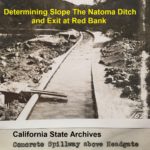In 1843, John Bidwell rode over the potential grant property with John Sinclair. The two men were examining the property for Nathan Spear who was considering petitioning the Mexican government for a land grant. William Alexander Leidesdorff would petition for the property and in 1844 was awarded a land grant named the rancho Rio de Los Americanos by the Mexican government. John A. Sutter subsequently rode over the property with Leidesdorff and would give him juridical possession of the property 4 leagues in width east to west, 2 leagues in length to the south, encompassing 8 leagues of land.











